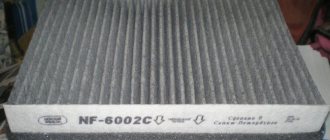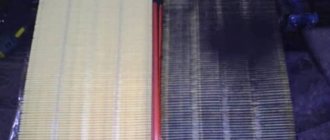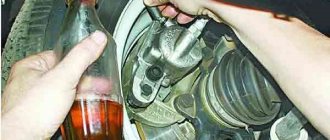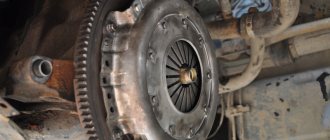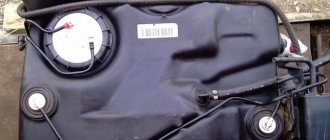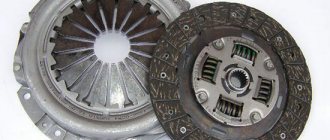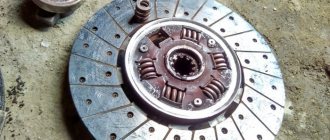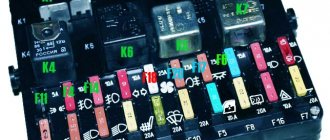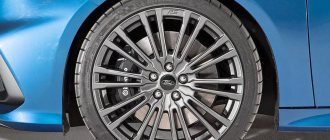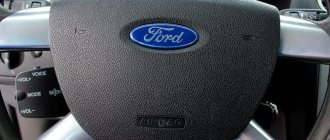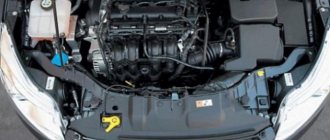The hydraulic clutch assembly in your Ford Focus should not require bleeding unless the system has been opened for repair. The clutch master cylinder and slave cylinder are supplied assembled, so major overhauls of the hydraulic system are not possible. It is recommended to bleed the brake system first if necessary since the brake and clutch systems share a fluid reservoir and the brake system has a larger volume in the cylinders.
Procedure for bleeding the clutch on a Ford Focus 2
Clutch failure is an unpleasant situation for many motorists; signs of such a malfunction are the inability to shift gears normally, and in many cases the gearbox must be removed to replace parts. But if parts of the hydraulic drive fail, or air gets into the system, repairs are much simpler; sometimes it is enough to just bleed the clutch.
Bleeding the hydraulic clutch drive (HC) on a Ford Focus 2 is not difficult to do, the work takes very little time. This standard operation on the Focus is performed in the same way as on other passenger cars with a manual transmission, only it is necessary that all parts of the hydraulic system are in full working order.
Ford Focus clutch components and adjustments
The Ford Focus transmission includes a gearbox, clutch and final drive.
To ensure that all elements interact flawlessly, they are connected by a precisely harmonized system of joints, shafts, bearings and gears. Ford Focus clutch for manual transmission
All manual transmission models feature a single-disc dry clutch, a design that is equally simple and efficient.
The disadvantage of the Ford Focus single plate dry clutch is that wear parts such as the clutch release bearing and driven disc are not very accessible.
Fig.2. Clutch Ford Focus
1 - clutch driven disc, 2 - clutch pressure plate (clutch basket), 3 - In all models with a manual transmission, the pressure plate has a diaphragm spring.
To do this, you need to disconnect the gearbox from the engine and dismantle it - a job that requires solid knowledge and special tools.
Therefore, it is better to leave the replacement of clutch units to a specialized workshop.
Ford Focus clutch replacement
Before replacing the clutch, the gearbox must be removed.
Replace the Ford Focus clutch in the following sequence:
— Unscrew all the fastening bolts of the clutch housing assembly crosswise. Reduce the tightening torque of the bolts by gradually unscrewing them 2 turns until the spring is completely unloaded; — remove the clutch cover with pressure and driven disks from the pins;
— measure the technical position of the clutch parts.
— Inspect the driven disk of the Ford Focus clutch, cracks on the parts are not allowed;
— Check the friction linings for wear. If they have an oily surface, then the driven disk needs to be replaced;
— Check whether the damper springs are securely fixed in the hub socket of the driven clutch disc;
— Check the runout of the driven disk;
The Ford Focus driven clutch disc is changed independently of the driving one when axial runout is detected greater than 0.5 mm, when the friction linings are oiled, cracked, scuffed or unevenly worn, when the rivet connections on the driven disc are loosened, and also when the distance between the working surface friction lining and rivet heads is less than 0.2 mm.
During assembly, the driven disk of the Ford Focus clutch is put on the input shaft of the gearbox, and the splines of the hole in the disk hub are constantly engaged with the splines of the input shaft.
In this case, the driven disk has the ability to move axially along the splines of the input shaft.
Install the Ford Focus clutch in the following sequence:
— clean the rubbing surfaces of the flywheel and pressure plate, remove dust from clutch parts, avoid the use of cleaning agents and solvents;
- using a centering mandrel, center the driven disk relative to the axis of the crankshaft
— Install the pressure plates on the flywheel. Tighten bolts 2 evenly crosswise. Tighten the bolts to a torque of 29 Nm, then remove the mandrel
Rice. 50. Centering the clutch driven disc Ford Focus
Rice. 60. Installing the Ford Focus clutch
1 - bolt; 2 — clutch casing assembly; 3 - centering mandrel
Fig.3. Hydraulic clutch control Ford Focus
A - clutch master cylinder with integrated release bearing - MTX-75 gearbox; B-clutch master cylinder with integrated release bearing - IB5 gearbox; 1 - synthetic cuff; 2 — air removal connection; 3 - supply pipeline; 4 — air removal connection; 5 — brake fluid level switch; 6 — expansion tank with brake fluid; 7 — topping pipeline; 8 — clutch pedal; 9 — clutch slave cylinder; 10 — safety clip; 11 - discharge pipeline.
Ford Focus clutch controls for the iB5 gearbox in a block with a drive axle
The clutch is hydraulically driven. The hydraulic clutch system uses brake fluid from a separate chamber in the brake fluid reservoir to power the hydraulic clutch system.
When you press the clutch pedal, the pressure in the clutch master cylinder increases. This pressure reaches the slave cylinder, which then acts on the clutch release bearing.
The advantages of a hydraulic clutch drive are as follows:
– Automatic adjustment – Low operating force – Minimal wear
Malfunctions of the hydraulic clutch drive
If the clutch disappears or is poorly pressed, the problem is often caused by air in the hydraulic system; air can enter the system as a result of:
- brake fluid leaks;
- master cylinder malfunction;
- leaks in connections.
It is necessary to pump the clutch only if all defects have been identified and eliminated, otherwise air will still be added to the fluid, and there will be no effect from pumping. If the system “airs”, signs of malfunction appear such as increased free play of the clutch pedal (PS), its too easy release (“cotton pedal”), and leaks of brake fluid.
How to bleed the Niva Chevrolet clutch?
1). Open the reservoir and fill it with liquid up to the neck. It is located in the engine compartment.
2). We put a hose on the fitting of the system cylinder, and immerse its other end in a container.
3). Next, the assistant needs to depress the clutch
(3-4 times), then hold it squeezed.
4). With the clutch pedal depressed, unscrew the valve and bleed the fluid in the system. After this, we close the valve and pressure is created in the system again.
5). We repeat this procedure until clean liquid comes out of the system, without air bubbles.
6). During the process, you should also periodically check the fluid level. And if necessary, you will need to top it up.
7). After pumping, add brake fluid to the reservoir to the MAX mark.
How to bleed the clutch on an Opel Astra?
1). We check the level of working fluid in the reservoir of the main brake cylinder (the reservoir is common for both main cylinders), and if necessary, bring it to normal.
2). Remove the protective cap from the clutch slave cylinder bleeder valve.
3). We put a hose on the valve and lower its end into a container with a small amount of brake fluid.
4). We ask the assistant to press the clutch pedal 5-6 times at intervals of 2-3 seconds, and then hold it pressed. While holding the hose adapter from turning, turn the valve 3/4 of a turn. Liquid with air bubbles will come out of the hose into the container.
5). We close the valve and ask an assistant to lower the clutch pedal.
6). We repeat this operation until liquid without bubbles flows from the hose, approximately 2-4 times.
Clutch bleeding procedure
On a Ford Focus 2 restyling 1.8, bleeding is carried out by bleeding air through the fitting of the clutch slave cylinder (CLC), this procedure is usually performed by two participants. An assistant is needed here in order to periodically press the PS, and a very important condition when pumping is not to forget about adding brake fluid (F) to the filler tank. In order to bleed the clutch on a Focus, you should prepare the following tools and materials:
- keys for eleven (especially for bleeding the brakes) and seventeen;
- a piece of transparent polyethylene tube;
- a container for draining the liquid (you can take a plastic bottle and make a hole in the lid for the tube);
- bottle of brake fluid (DOT-4 recommended).
We pump the GPS as follows:
- pull off the cap from the RCS fitting, it protects against dirt;
- We attach a polyethylene tube to the tip of the fitting, and take its other end into a container prepared for draining;
- the second of the participants presses the pedal several times (“pumps up the clutch”), holds the pedal pressed with his foot;
- We unscrew the fitting using a bleeder wrench, holding the RCS (its plastic adapter) with a 17 wrench, loosen it by about three-quarters of a turn, air should come out of the working cylinder along with the brake fluid;
- PS remains pressed, then tighten the fitting;
- Now in the cabin you need to release the pedal and repeat the inflation;
- again we carry out the operation of bleeding the air, performing all these actions until liquid without air begins to flow out of the control center.
All this time you need to monitor the level in the tank, and when it drops closer to the minimum, periodically add fuel fluid to the top. At the end of pumping, we check the fluid level again (it should be between the min and max marks), screw on the reservoir cap, and check the operation of the car while driving. In this case, the pedal should be sufficiently elastic; if necessary, we pump it again. For the Ford Focus 2 restyling 1.6 version, the clutch is pumped in exactly the same way, the procedure does not change here.
Parts and consumables:
Then we tighten the fitting, and the partner repeats the pumping procedure. Repeat until the liquid flows without bubbles. We move to the front left wheel and repeat the same steps. In order not to air the system, we periodically check the fluid in the tank and add it if necessary. Then we repeat everything with the rear left and then the front right wheels, do not forget to put rubber caps on the fittings.
Replacing the clutch master cylinder for Ford Focus 2
We check the level of working fluid in the master brake cylinder reservoir; the reservoir is common for both master cylinders, and if necessary, bring it up to normal. Remove the protective cap from the clutch slave cylinder bleeder valve. We put a hose on the valve and lower its end into a container with a small amount of brake fluid. Ask an assistant to press the clutch pedal once at intervals of seconds, and then hold it pressed.
Liquid with air bubbles will come out of the hose into the container. We close the valve and ask an assistant to lower the clutch pedal.
We repeat this operation until liquid without bubbles flows from the hose, approximately once. How to bleed the clutch on a Ford Focus 2 1. Unscrew the valve cap to remove air from the slave cylinder. The prepared tube is put on the fitting, and its other end is lowered into a container with brake fluid.
We put the tube on the fitting of the working cylinder, and lower the other end into a bottle of brake fluid. Press the clutch pedal five to seven times and hold it down. An assistant will do this. Using a 17mm wrench, we hold the body of the fitting adapter, and unscrew the fitting itself with the tube in place a third of a turn or a little more, but until liquid flows out of the tube.
Unscrew the bleeder fitting a little more than half a turn. Unscrew the valve approximately three-quarters of a turn, while using a second key to hold the adapter fitting of the main cylinder of the shutdown drive.
Liquid from the tube will begin to flow into the prepared container, and there will be air bubbles in it. Unscrew the bleeder fitting a little more than half a turn. Screw in the valve and instruct the assistant to depress the pedal. Do this until the liquid flowing from the tube has no bubbles. When pumping, constantly monitor the level.
3.1. Ford Focus II. Bleeding the hydraulic clutch release drive
When I unscrewed the fitting on the working cylinder, air confidently came out of it. To find out where the air comes from in the system, I tried different things, but nothing helped. I tried downloading in three ways.
The first one is ordinary with a tube immersed in the brake fluid. The second one used a huge syringe to pump brake fluid into the fitting until it appeared in the reservoir.
The third one used a syringe to fill the brake fluid into the main cylinder separately, then into the working cylinder, then connected everything with a pipeline and pumped it with a tube immersed in the brake fluid.
Some features of the Ford Focus 2 hydraulic clutch
Focus car owners often ask how to adjust the clutch if the pedal “snaps” late. It should be noted that on this model the Ford GPS is not adjustable; somehow changing the operation of the unit can only be done by pumping the hydraulics.
Another interesting solution from the Ford concern, used in the design of the car, is combining the RCS with a release bearing, so to replace the working cylinder you have to remove the gearbox. Also, extra work is added when changing the clutch release, because in any case you need to pump the clutch.
When the PS is easily pressed, “pushed” to the end almost with your fingers, most likely the clutch master cylinder (MCC) is faulty. If the standard location of this part on many passenger cars is under the hood, next to the wiper panel, then on the Focus the GCS is located much lower, in close proximity to the clutch pedal, and is connected to it mechanically.
The clutch basket and disc on these cars usually last for 100-150 thousand km, much depends on operating conditions. But the release bearing may fail much earlier, and in this case you will still have to remove the gearbox and do quite serious repairs.
How to bleed the clutch on a Mercedes Sprinter
1). We lift the car from the front and place its front part on stands.
3). Fill the brake fluid into the reservoir to about.
4). We remove the dust caps from the fittings to remove air from the working cylinder and from the front caliper of the disc wheel brake mechanism. Carefully loosen the fittings to remove air. We put a hose on the fitting, which is located on the front disc brake caliper.
5). We fill the hose with brake fluid, and therefore the fitting on the caliper must be carefully opened. An assistant slowly depresses the clutch pedal and holds it pressed. Close the air bleeder and lower the brake pedal. We repeat the operation until the hose is completely filled with brake fluid.
Replacing and adjusting the Ford Focus 1 clutch
The Ford Focus 1 has a design whose reliability is beyond doubt among consumers and has been proven over years of successful operation. However, after a certain time, it may be necessary to replace or repair various components and systems, including clutches.
The main function of the clutch is to reduce gearbox jerks, interrupt engine torque when changing gears, etc. In addition, it plays the role of a safety clutch and is a means of ensuring safety. As a result, damage and destruction of more expensive components, including the gearbox, drive axle and engine, does not occur.
Replacing the clutch in a Ford Focus 1 (Ford Focus 1), video
Learning to change the clutch on a Ford Focus
1 with your own hands. Replacing the clutch. one of the most common types of car repairs. On average, the service life of domestically produced clutches does not exceed 70-80 thousand kilometers, compared to imported ones. 1.5 times more. The choice of a new unit must be approached extremely carefully and carefully, since low-quality counterfeits are widespread on the domestic market, which not only do not provide any reliable operation, but can also cause road accidents, including those with tragic consequences. We must remember that the clutch in a car, in addition to its normal functions. interrupting engine torque when changing gears, reducing transmission jerks, is responsible for safety, being, in fact, a safety clutch, which in a critical situation should prevent the destruction of more important and expensive components (engine, gearbox, drive axle).
Video of clutch replacement on Ford Focus 1:
From the video you can learn various recommendations regarding replacing the Ford
Focus 1 and its adjustments.
After dismantling the old clutch, the flywheel surface must be degreased and at the same time checked for wear. It should also be remembered that the friction linings of the clutch disc are very hygroscopic, so if you accidentally allow oil or other liquids to get on them, they will be instantly absorbed, and in this very place the disc will locally slip and overheat during operation, which will significantly reduce its service life . Based on this, it is advisable to carry out all work with a new clutch with clean hands. To clean the clutch, aerosols are often used, which are used to degrease the brake linings, but this should never be done, because the material for their manufacture is fundamentally different. Before installation, the new clutch should be checked for runout. In cases where the lateral runout of the disc exceeds 0.5 mm, the clutch will slip slightly at the misalignment point due to incomplete separation of the basket and disc.
It is highly recommended to replace the slave cylinder and release bearing at the same time as the clutch, since the previous parts will no longer have the necessary properties after disassembly. Before dismantling the new disk, clean the shaft of dirt and check the alignment of the splines, being careful not to touch the friction linings with your hands. The disk should move freely and effortlessly along the shaft. We lubricate the parts thoroughly, but not excessively, and remove excess lubricant from both sides of the disk. Next we mount the release bearing. We carry out all work only with hand tools to avoid undesirable consequences. When installing, also pay attention to the condition of the tangential springs. They are what give the clutch smooth operation. If one or more tangential springs are damaged, the alignment of the parts during operation of the unit will be incomplete.
When installing the clutch, it is necessary to use a set of special mandrels that ensure alignment as accurately as possible during installation. If they are not used, the basket may move vertically or horizontally, and the box will not fit back into place when reassembled. We tighten the fastening bolts in a star pattern, not one after another. This will ensure a uniform fit of the basket plane during operation. We gradually increase the tightening force of the bolts, and the final tightening should be carried out with a torque wrench only once until it clicks (according to the prescribed torque).
Signs when it is necessary to change the clutch or bleed/adjust it
As a rule, this unit has a fairly long service life and must be replaced after approximately 70-80 thousand km on domestic cars, and on Ford Focus 1 it can last up to 150 thousand km. It is worth noting that the service life of the clutch is directly affected by factors such as load level, operating conditions, etc.
To determine whether the clutch needs replacement, you should pay attention to a number of signs:
- A specific noise that occurs when you press the clutch pedal.
- When turning on and changing gears, jerking occurs.
- Incomplete engagement of the clutch (the clutch slips or “leads”).
Special attention should be paid to choosing a new clutch, since car owners often choose products of poor quality. As a result, this causes incorrect operation and premature failure, resulting in an emergency situation.
How to bleed the clutch on a VAZ 2110, 2111, 2112
1). We drive the car into the inspection hole, then open the hood and find the brake fluid reservoir (see photo). Unscrew the cap from the barrel and add brake fluid to the MAX mark.
2). After topping up, we close the tank lid so that no air gets into it, or we simply put it on top and then move under the bottom of the car.
3). The assistant gets behind the wheel at this time. By the way, during the bleeding process it is necessary to monitor the level in the brake reservoir. Namely, it should not fall lower than 15 mm. It’s better to add brake fluid to the reservoir more often, otherwise you never know.
4). Next, ask your assistant to smoothly press the clutch pedal 5-10 times, and on the last press, to press it down and hold it on the floor while you perform one operation.
5). At this time (depending on which wheel you are bleeding) remove the protective cap from the pumped fitting. For example, on the rear wheel the bleeder fitting is located where shown by the arrow in the right photo, and on the front wheel this part and its protective cap are located where indicated on the left
(The photo below shows an example on the front wheel; on the rear, everything is done identically)
What kind of clutch fits Ford Focus 1
All Focus models with manual transmission use a single-plate dry clutch. Its advantage is that it is equally a fairly practical and simple design. There is one significant drawback in this clutch; it is due to the fact that wearing parts, for example, the driven disc and release bearing, are not very accessible. To access it, you need to disconnect the gearbox from the engine and dismantle it, and this is a job that requires special tools and certain knowledge. Therefore, it is more appropriate to leave the replacement of clutch units to specialists.
Summarizing
High-quality and professional repairs are the key to long-term operation of your car. However, service specialists do not always take their work seriously, and therefore the effectiveness of their actions is low. If you think that you are capable of pumping the clutch yourself, do it, taking into account the recommendations of our article. Armed with the tools and help, you can fix your second-generation FordFocus and save yourself from more serious problems down the road.
Sources:
https://v-mireauto.ru/kak-prokachat-sceplenie/ https://avtodoc24.ru/kak-prokachat-stseplenie/ https://avtosfera76.ru/remont-i-zamena/kak-prokachat-stseplenie- na-FORD-fokus-2.html https://FORDprof.ru/FOCUS-2/prokachka-stsepleniya-FORD-FOCUS-2.html
How to change the clutch
Replacing the clutch yourself is not a complicated procedure and requires certain actions. To do this you need:
- Remove the gearbox.
- Mark the location of the disc housing and flywheel (this is only necessary if installing an old pressure plate).
- Remove the bolts securing the disc to the flywheel.
- Remove the pressure and driven discs. It is important to inspect the driven discs for chips, cracks and other damage.
- Next, inspect the friction linings. The driven disk must be replaced if the linings are covered with oil, the rivets are recessed by 0.2 centimeters or less, and also if the connections are loose.
- Inspect the places where the driven disk is fixed in the hub, carefully moving them with your hand. When they are damaged or move too freely, the disc must be replaced.
- Check the driven disk for runout. If it exceeds 0.5 mm, then it also needs to be replaced.
- Inspect the contact surface of the flywheel and pressure plate. If scuffs, scratches, or signs of wear are noticeable, replacement of components is inevitable.
- Next, replace the pressure plate and inspect the diaphragm spring (there should be no damage to it).
- Check the joints between the casing and disk links. If there is damage, the pressure plate needs to be replaced.
- Inspect the compression spring rings from all sides. There should be no cracks, chips, etc. on their surface, otherwise they will need to be replaced.
- Check the movement of the driven disk for ease of movement along the channels of the gearbox shaft. If it jams, a solution to this problem is required.
- Apply special lubricant (grease) to the hub splines.
- Install a new clutch.
After the clutch has been replaced, you need to check the functionality of the unit. First, just depress the pedal, then alternately shift all gears and test the car on the move. If problems occur, the clutch needs to be adjusted.
Other signs of clutch failure
When the friction linings wear critically, the behavior of the car changes significantly. The following are signs of a burnt coupling:
- It is difficult to start moving. The car can remain stationary even when the clutch pedal is fully released. This means that the disc is not pressed enough to transmit torque to the transmission. Here you can judge the critical wear of the driven disk.
- Car jerking while driving. In this case, you can still start moving, but the start will create discomfort - the car jerks strongly. When the speed increases, the jerking disappears. However, the next time you try to drive from first gear, the jerking and vibration will appear again. In addition, the car may accelerate atypically when switching to higher speeds. Since the disk is not pressed tightly enough to the flywheel, the torque is transmitted intermittently. The car loses acceleration dynamics. If you disassemble the coupling, you can see the play of the diaphragm springs. They are responsible for compensating and smoothing the loads coming from the flywheel to the transmission. If such play is detected, the mechanism must be replaced.
- Free play of the clutch pedal.
Based on these signs, you can judge whether the clutch is faulty without additional diagnostics. However, to get the full picture, it is better to contact specialists.
After we have decided on troubleshooting, it’s time to choose the best clutch kit for your car, our rating.
How to bleed the clutch
The process of bleeding the clutch is recommended to be carried out in the garage, but if it is not available, it can also be done in the field, since it does not require special tools and devices.
To bleed the clutch you need:
- Brake fluid (new).
- Empty container.
- Rubber hose that fits the fitting.
- A device that can be used to lock a clutch. As a rule, a “gas stop” is used for this, but other tools can be used. Clutch locking devices will not be needed if you have an assistant who can take on this task.
- Set of automotive tools.
Important! Before you start bleeding the clutch, you need to adjust the clutch, because without ensuring easy movement of the cylinder piston pusher, there is no point in bleeding the clutch. In addition, you should make sure that the brake fluid complies with the car manufacturer's recommendations. Using the wrong fluid can cause clutch failure due to swelling of the rubber linings.
- Clean the master cylinder reservoir as thoroughly as possible.
- Add TJ into the tank so that there is about 2 cm of free space left.
- Remove the cap from the bypass valve (located in the pneumatic hydraulic booster), and put a hose of a suitable diameter on it.
- Pour about 200 ml of fresh brake fluid into a container and lower the hose into it.
- Next, unscrew the bypass valve one turn and depress the clutch pedal to the maximum (with the help of an assistant). The clutch must be released slowly, but at the same time make sure that the hose is in the liquid for a while. The release of air will be indicated by the signs that appear on the surface of the liquid poured into the container. Note! When depressing the clutch, it is necessary to monitor the fluid level in the reservoir. When it is lower, more than 3.5 cm from the upper limit, it needs to be topped up.
- When the clutch pedal is depressed to the maximum, you need an assistant to continue to hold it in this position. At this moment, you need to quickly tighten the bypass valve and release the pedal.
- Open the bypass valve one turn (at this time the assistant presses the pedal). Repeat this action 3-4 times or until all the air has left the clutch.
- Next, tighten the bypass valve, remove the rubber hose, and put the cap on the fitting. If necessary, after completing the work, add brake fluid to the value required by regulations - 1.5-2 cm from the top edge of the reservoir.
This completes the work on bleeding the clutch. If the clutch is in good condition, then there will be no problems with airing.
Based on this, it is worth concluding that by spending a small amount of time you can save a lot by replacing and pumping the clutch yourself. But most importantly, you can be confident in your Ford Focus 1.
How to bleed the clutch on a LADA Largus?
1). We add fluid to the brake reservoir to the MAX mark and begin pumping the brake system from the far longer circuit.
2). On the back of the drum we find a drain fitting with a rubber cap on. Remove the cap.
3). We put an “8” spanner on the fitting, and then a hose. We lower the second end of the hose into the drain container.
4). Next, the assistant presses the brake pedal 4-5 times, and then leaves it in the pressed position.
5). Unscrew the drain fitting slightly by turning it counterclockwise 1/3 of a turn. At the same time, brake fluid will begin to flow out of the hose, and the clutch pedal will sink to the floor. Then we tighten the fitting, and the partner repeats the pumping procedure. Repeat until the liquid flows without bubbles.
6). We move to the front left wheel and repeat the same steps.
7). In order not to air the system, we periodically check the fluid in the tank and add it if necessary.
THE MOST EFFECTIVE WAY TO BLEED THE CLUTCH: ALONE, IN 3 MINUTES, WITHOUT PRESSING THE CLUTCH PEDAL
8). Then we repeat everything with the rear left and then the front right wheels, do not forget to put rubber caps on the fittings.
The process of bleeding the clutch on a Ford Focus 2
The procedure for bleeding the Ford Focus 2 clutch - the video of which is presented at the bottom of the article - is quite simple and does not require a lot of time and qualifications of an auto mechanic. It is enough to carefully read the material we offer and strictly adhere to all points of the instructions.
The hydraulic drive has a common reservoir with the brake system. As a result, as a rule, after the brake fluid is changed and all components of the brake system are pumped, the clutch system also needs to be pumped. If the pedal movement seems “soft” to you, this means that there is air in the clutch drive system that needs to be removed.
When will we bleed the clutch?
Bleeding the clutch on the second Focus is necessary in cases where we decide to replace the brake fluid due to wear or after repairing the working or master cylinder of the clutch hydraulic drive. In addition, bleeding cannot be avoided if air gets into the hydraulic drive system. This can happen due to our oversight, when the fluid level in the tank drops below the minimum and when trying to disengage the clutch, air is sucked into the system along with the fluid.
Ford Focus 2 clutch parts
Bleeding will get rid of air in the line, and it is easy to find out that there is air in the system - if the clutch does not disengage completely after the first press of the pedal, but after several repeated presses it still separates the flywheel and the basket, you can guarantee that the system air got in. Before pumping the system, you need to determine whether everything is in order with the tightness of the line, whether there are any leaks on the body of the main and working cylinders, and whether liquid is leaking into the passenger compartment along the engine shield. Once you have verified that the system is working properly or the leak has been eliminated, you can begin pumping.
For work, we will need a 17mm wrench and a special 11mm split wrench for the brake system fittings, as well as new, clean brake fluid.
In addition, you will need a tube that can be put on the fitting and a clean container with a small amount of brake fluid. And an assistant, since it’s possible to work alone, but it’s extremely inconvenient. Let's start pumping.
Bleeding the clutch
Immediately before starting bleeding, adjust the clutch itself. The bottom line is that pumping the system is ineffective if there is no free movement of the main cylinder piston pusher, which acts as a shut-off valve, and if there is no movement, it will be in a closed state.
Tools
- key to "eleven";
- key to "seventeen";
- Screwdriver Set;
- brake fluid;
- container for draining the old one;
- a hose or tube for bleeding, the diameter of which coincides with the diameter of the drain fitting;
- assistant.
Step-by-step instruction
If you press the clutch and it does not disengage completely, and you hear a specific grinding noise when you engage reverse gear, it is likely that the hydraulic drive is airy and needs to be bled.
When is it necessary to bleed the clutch?
There are several signs that can indicate that the clutch on your second generation Ford Focus needs bleeding.
Firstly, if when you press the pedal all the way, the clutch does not disengage 100% (people say that it is driven), and a grinding noise is observed when reverse gear is engaged. This could mean air is getting into the hydraulic drive. Secondly, if you are changing the hydraulic fluid or repairing the system due to its depressurization, then you will also need to work on the clutch. The main reason why the clutch is pumped is to remove air from the cylinders, or more precisely from the brake fluid. The fact is that if there is air in the system, the clutch will not work correctly - it will not disengage completely, and the pedal itself will be very light. Therefore, if you find problems with the clutch system, you need to fix them as quickly as possible, since operating a Ford Focus with any damage is simply dangerous.
How to bleed the clutch / Ford Focus 1 – FFClub
How to bleed the clutch
Unscrew and remove the left fender liner. I tried downloading in three ways. The documents say that the pedal should move from the floor plus or minus 3 mm.
Ford Focus Wagon MT station wagon › Logbook › Replacing brake fluid - bleeding the clutch. Everyone...
We pull the gearbox to the engine, supporting them as they were before removal. Dirty pipeline connections to cylinders, worn pipeline. And an assistant, since it’s possible to work alone, but it’s extremely inconvenient.
To do this, you need to press the pedal all the way and check the stroke of the piston pusher. Although after pumping, when the pedal becomes elastic for the first couple of kilometers, you can see how the release lever confidently presses on the petals. We repeat the cycle of squeezing out air until no more air bubbles come out of the tube.
When I unscrewed the fitting on the working cylinder, air confidently came out of it. To find out where the air comes from in the system, I tried different things, but nothing helped.
Comments and reviews
I tried downloading in three ways. The first one is ordinary with a tube immersed in the brake fluid.
The second one used a huge syringe to pump brake fluid into the fitting until it appeared in the reservoir. The third one used a syringe to fill the brake fluid into the main cylinder separately, then into the working cylinder, then connected everything with a pipeline and pumped it with a tube immersed in the brake fluid.
Remove the rubber protective cap from the fitting. The prepared tube is put on the fitting, and its other end is lowered into a container with brake fluid. We put the tube on the fitting of the working cylinder, and lower the other end into a bottle of brake fluid.
Press the clutch pedal five to seven times and hold it down. An assistant will do this.
How to adjust the clutch? Ford Focus
FF1 2003 1.8 manual, is it possible to adjust the clutch at home and how to do it.
Thank you, this is all clear, I meant how to get to the cable. you can’t see anything from above, I used to ride on a basin, everything is simple there, but here something is piled up
Does anyone have any pictures?
to maksunoff45:
Everything is intuitive there.
There are no pictures, unfortunately.
I removed the air filter, battery, battery box, I can’t find the lever, and the cable is also not visible, maybe the drive is hydraulic? How is the rod on the pedal assembly adjusted?
maksunoff45:
maybe a hydraulic drive? #
Then see if the hose goes to the clutch housing?
maksunoff45:
Does anyone have any pictures? #
Yes, everything is exactly like in the picture. So the clutch is not adjustable?
to maksunoff45:
Adjustable. Only on the master cylinder.
Messir:
Adjustable. Only on the master cylinder. #
That's the question, how? The opposite is said here.
Wait for slipping and change the clutch.
Check the free play of the clutch pedal, it should be about 5cm.
Source
Bleeding the hydraulic clutch
In short, carefully pull the entire shaft and pull it out of the gearbox. Now we also move the stand and the fist to the left to the side, while removing the shaft from the hub or knocking it out if it is firmly seated, or using a special puller we squeeze out its drive shaft.
Then he takes a slotted screwdriver and carefully presses it, inserting it into the hole from the right shaft into the gearbox, but in no case should you hit anything in the gearbox around it and rest the screwdriver firmly against the shaft that was spinning. Now the assistant, to make sure that the screwdriver is in the right place, staggers the shaft towards the gearbox and away from the gearbox as much as possible, if the screwdriver walks with the shaft, then we carefully begin to hit it with a hammer through the board.
At the same time, visually checking and monitoring that we are knocking in the right place and not damaging anything around the checkpoint. The left shaft comes out of the gearbox and the remaining oil drains from the gearbox. Now you can take it out and set it aside, being careful with it. There is a retaining ring on it - if it is ok, then leave it, if it is bad, then replace it.
All holes in the gearbox need to be plugged so that nothing falls or gets in there. At the same time, the support must also support them; it cannot be removed completely.
How to change the clutch master cylinder
We remove the hose, wipe the bleeder fitting dry and put a protective cap on it. We install the mudguard in place. Add fluid to the reservoir, bringing its level to normal.
If necessary, you can bleed the clutch hydraulic drive by freeing access to the fitting from above through the engine compartment. Do this until the liquid flowing from the tube has no bubbles. When pumping, constantly monitor the level.
Under no circumstances should it be allowed to fall below the minimum level. Do not be late in adding fluid - otherwise, if the level drops very low, there may be air in the system and all operations will need to be repeated again.
How to bleed the clutch on a Skoda Octavia?
1). We check the fluid level in the reservoir of the main brake cylinder of the Skoda Octavia (the reservoir is common to both systems) and, if necessary, bring it to normal.
2). Remove the protective cap from the air bleed valve on the clutch slave cylinder.
3). We put a hose on the valve and lower its end into a container with a small amount of brake fluid. We ask an assistant to press the clutch pedal 4-5 times and then keep it pressed.
4). Turn the valve ¾ of a turn. Liquid with air bubbles will flow out of the hose into the container.
5). During pumping, do not forget to monitor the level of brake fluid in the reservoir. And if necessary, add it to the maximum level.
6). We wrap the valve, put on the protective cap and, if necessary, add fluid to the hydraulic brake and clutch release reservoir.
How to bleed the clutch of a Ford Focus 2
There are a number of signs that indicate that the Ford Focus II clutch should be bled as soon as possible. So, if when the pedal is fully depressed the clutch does not disengage 100%, but a grinding noise occurs when reverse gear is engaged, this situation may indicate the presence of air in the assembly. In addition, if the lubricant was changed or repairs were made due to the loss of tightness of the unit, this also becomes an indication for working with the clutch.
What you need to know to bleed the FORD Focus 2 clutch
The second generation Ford Focus has a fairly simple design, despite the fact that all systems are modern and reliable. This means that if any malfunction occurs, you can fix it on your own. Of course, for this you need to have a minimum set of tools, knowledge and experience. If you are not confident in yourself, then it is better to seek help from specialists. In our article we will talk about in what situations you will have to upgrade
clutch, how to do it and what is needed for it.
How to bleed the clutch on a Ford Focus II
Next, you need to understand how to bleed the clutch on a Ford Focus II. For this action it is important to have certain devices on hand:
To make the work go quickly and comfortably, you should ask a friend to help you. The Ford Focus 2 clutch pumping itself occurs according to the following scheme:
- To remove air from the working cylinder, you need to unscrew the valve cap.
- We put the hose on the valve and lower the other end into the container for draining. We press the clutch 4-5 times and press the pedal, holding it in this position.
- Slightly unscrew the valve, supporting the connection of the switching drive. If this procedure is carried out correctly, bubbling grease will flow into the container.
- Unscrew the fitting a little more, screw in the valve, starting to slightly press the clutch. If the clutch on a Ford Focus 2 is lost, this process should be performed until all brake lubricant is completely cleared of bubbles.
- Now you can tighten the valve, install the cap and add the required amount of new lubricant to the assembly.
It is important to understand that when performing these actions, it is important not to forget about monitoring the fluid level - you must not allow the lubricant level to fall below the minimum limit. It is necessary to fill in new fluid in a timely manner so that the system does not become saturated with air, otherwise the entire pumping procedure will be in vain and will need to be performed again.
When you have completed pumping, you should make sure that the entire system is working correctly. Squeeze the clutch and watch the placement of the piston pusher. The travel of this unit should be within 28 millimeters, but if the existing indicators do not match, adjustment of the clutch pedal is required.
The brake fluid should be a lubricant recommended by the car manufacturer. If you ignore the situation and use other products, the rubber elements may increase, which often causes the entire clutch to fail.
How to bleed the Chevrolet Lacetti clutch?
1). Fill the brake reservoir with fluid up to the “MAX” mark.
2). Next, we try to carefully “rip off” the fitting. To do this, apply WD-40 to the threads and leave for 5-10 minutes. After this, use the “19” key (as shown by the arrow in the photo) to put it on the head of the fitting (circled in an oval) and, holding the plastic with the key, carefully unscrew the fitting.
READ Replacement Butterflies Ford Focus 2
3). When the fitting has “broken off,” we pull it back a little and put a transparent tube on it. We lower the second end of the tube into a container with a small amount of brake fluid.
4). We ask the assistant to depress the clutch pedal 3-4 times and to keep the pedal pressed after the last press.
5). Slowly unscrew the bleeder fitting so that the liquid begins to come out of the tube, while the assistant continues to press the pedal.
6). After the brake fluid stops coming out of the tube, tighten the fitting.
7). These steps must be repeated until liquid with bubbles stops coming out of the pumped fitting. And only after this do we finally tighten the fitting.
8). During the pumping process, you also need to monitor the level of liquid in the tank and, if necessary, add it.
9). If everything is normal and there are no more bubbles, then remove the vinyl tube and key from the fitting, put a protective cap on the fitting, add liquid to the level and screw on the tank cap.
Useful tips for long-term use of the Ford Focus 2 clutch
In order for the entire assembly to work smoothly and for a long time, you should not keep the clutch clamped for a long time. Beginning car owners often suffer from this after studying at a driving school. There are two dangers in this situation:
- Your leg will get tired quickly.
- The pedal remains in the depressed position, that is, the driven disk slips and wears out. Although the release bearing assumes a long service life, constant pressing and holding will reduce the life of the part.
If you had to stand in a traffic jam or at a traffic light, it is better to put the car in neutral and use the clutch only while driving. When the clutch slips, it is noticeable on the tachometer readings. If pressing the gas pedal sharply increases the speed, but soon it drops, and only then the car begins to accelerate, it’s time to adjust the clutch pedal. The assembly may need to be completely replaced.
How to bleed the clutch on a LADA Largus
1). We add fluid to the brake reservoir to the MAX mark and begin pumping the brake system from the far longer circuit.
2). On the back of the drum we find a drain fitting with a rubber cap on. Remove the cap.
3). We put an “8” spanner on the fitting, and then a hose. We lower the second end of the hose into the drain container.
4). Next, the assistant presses the brake pedal 4-5 times, and then leaves it in the pressed position.
5). Unscrew the drain fitting slightly by turning it counterclockwise 1/3 of a turn. At the same time, brake fluid will begin to flow out of the hose, and the clutch pedal will sink to the floor. Then we tighten the fitting, and the partner repeats the pumping procedure. Repeat until the liquid flows without bubbles.
6). We move to the front left wheel and repeat the same steps.
7). In order not to air the system, we periodically check the fluid in the tank and add it if necessary.
8). Then we repeat everything with the rear left and then the front right wheels, do not forget to put rubber caps on the fittings.
What clutch malfunctions are common on Ford Focus II cars?
To know how to check the clutch on a Ford Focus 2, you need to know common problems with this unit. So, the clutch may not fully engage, for which there are reasons:
- The pedal travel has decreased - it’s worth figuring out how to adjust the clutch and performing this action.
- The driven disk failed, and the end runout exceeded 0.5 millimeters. This situation requires replacing the lining or the entire assembly.
- The hubs of the driven disk become jammed under the conditions of the starting shaft of the gearbox. The solution is to clean the splines and apply a special lubricant to them. If jamming occurs as a result of wear or damage to the splines, you will need to replace the input shaft or the disk itself.
- The friction plate is broken or the rivet is loose. Replacing failed elements will help resolve the situation.
- There is air in the hydraulic drive - it is necessary to bleed the clutch as quickly as possible.
- Lubricant leaks from the main cylinder or hydraulic contacts. There is no need to hesitate here either. In the first situation, you need to change the cylinder, and in the second, stretch the contacts or install new elements instead of worn ones.
- If the pressure plate is damaged or the spring rivets are loose, replace the assembly housing.
The following situation is when the clutch is not fully activated. The problems and solutions are:
- The node is worn out or damaged - you should find the problem and get rid of it.
- Lubricant appears on the friction plates of the driven disc on the back of the pressure and flywheel. The best solution to the problem is to use white spirit to wipe all surfaces.
- Significant wear or sticking of the plates, which can be corrected by replacing the linings or driven disk.
- The free play has disappeared - the system drive needs to be adjusted.
When the clutch is activated on the Ford Focus II, jerking may occur, which is a consequence of the following factors:
- Excessive wear of the driven disk plates, which can be solved by installing new product components.
- If the hub is stuck, it is necessary to clean the splines using special lubricant LSC15. If the splines are damaged, the only solution is to install a new input shaft or driven disk.
- Loosening the rivets of the disc plates - installing new plates or rivets.
- Jamming of the system mechanism - we look for damaged elements and replace them.
- There is oil on the friction plates of certain system elements - you need to wipe the coating with a solvent and get rid of the cause of this problem.
Another unpleasant situation is that when disengaged the clutch is too noisy. This situation occurs when there are problems with the bearing, and it is best to replace this element. Sounds can also occur when the unit is activated, which occurs as a result of a decrease in the strength of the damper springs, loss of brake fluid, or failure of the linings. All problems can be resolved by replacing parts.
How to bleed the clutch of Renault Megane 2
1). In the photo, the arrow indicates the Renault Megane 2 fitting, intended for bleeding the clutch system (working cylinder).
2). To make the work easier, remove the battery and dismantle the platform underneath it.
3). Remove the cap from the brake fluid reservoir and top it up to the maximum mark.
4). We clean the plug on the fitting from dirt and remove it.
5). We put a pre-prepared hose on it.
6). Attach the syringe to the reverse side.
7). The next step is to distribute the spring clips on the fitting.
Clutch bleeding for Ford Fusion, Fiesta, Focus 2, etc.
8). First of all, lower the lock on the right all the way down.
9). Next, lift the left one up until it clicks.
10). We extend the black tube located on the right side approximately 5 mm in the direction of the battery, i.e. to the right.
eleven). After completing these procedures, use a syringe to draw the liquid out of the system.
Next, when your syringe is full, you must first push the black tube back into place (to prevent air from getting in), and only then disconnect the syringe from the hose and pour out the pumped out liquid. Then we put everything back in place and continue working.
12). We repeat this procedure until all the bubbles have completely left the system. As a rule, 2-3 repetitions are enough.
13). Don’t forget to also monitor the brake fluid level and top it up if necessary.
14). Once air bubbles have stopped flowing into the syringe, this will mean that your system is bleed.
15). We push the black pipe into place, put all the metal fasteners in place and attach the rubber plug.
Liquid
To be precise, the clutch
Ford Focus
is bleeding. Removing air formations from the control system. Typically, air enters through worn pipes or insufficient connections.
- A set of tools that is in any garage;
- Packing brake fluid (TJ);
- Empty tanks for draining waste fuel oil;
- Hose of the correct diameter for drain fittings;
- Assists or clutches on the clutch pedal (if done independently)
Before starting the process, you need to configure the system. The pedal must travel freely and the springs must be adjusted. If you do not know how to pump up a Ford Focus 2, it is advisable not to risk using the services of professionals.
correct bleeding of brakes or clutch on a Ford Focus alone
How to pump up the clutch on a Ford Focus 3.
Clutch system. self-pumping process:
- The first thing to do is add brake fluid to the cylinder barrel at a distance of 1-2 cm from its top edge. It is recommended to fill the liquid through the filter to avoid unwanted inclusions (dirt, dust, contaminants) entering the system.
- On top of the CCGT, remove the rubber valve cap and secure the drain hose. The other end is placed in a prepared container (1 liter), already filled with brake fluid (300 ml).
- Unscrew the intake valve 1-2 turns and press (assistant) the pedal several times. This is necessary to ensure that trapped air leaves the system.
- If necessary, it is necessary to add brake fluid to the tank so that its level does not fall 1-2 cm from the top.
- Once all the air has been released and the pedal continues to be pressed fully, tighten the valve tightly.
- Remove the hose, secure the cap and add TG to the system if necessary.
Next, we check the quality of the work performed. The partner compresses the pedal as much as possible, and you look at the stroke of the pusher. The optimal moving distance is 28-30 mm.
What tools are needed?
To successfully replace the GVC, the car owner needs the following tools:
With ratchet and universal joint for heads
Removal of the bracket from the main center system is carried out in a confined space. There is not enough space to get the key in. Therefore, it is better to use a universal joint for the heads.
When replacing the GCS, a rag is required. Since the working fluid reacts with oil, rags should not be stained with grease. The presence of lint or loose threads is also unacceptable.
Installation process
- The adjustment begins by rotating the nut with the same name. Then resume pedal travel to 125mm. We increase its stroke by tightening the tip of the nut.
- Then you need to press the pedal three to four times and measure the distance between the floor. If necessary, do this until we reach the required distance from the pedal to the floor.
- Installation of a hydraulic clutch system: the distance from the rod to the fork is no more than 4-6 mm. Remove the spring using the cylinder clamp and bleeder plug.
- Next, adjust the nut on the rod so that the distance between the forks does not exceed 6 mm.
READ Replacing the right-hand drive bearing for Ford Focus 2
Causes and Troubleshooting
There are a few things you might want to know about a possible faulty pedal of no return:
- If the pedal fails, the clutch cable at the tip may have been broken and torn off. Such breakdowns are increasingly difficult to fix on the road with your own hands. Some “Kulibins” offer to carry the cable themselves, since a spare tire, unfortunately, is not possible, what remains for our client to do in order to place the necessary parts in the trunk?
- Exploded, as they call it, the rotating spring returned. In the first case (explosion and malfunction). then call only for a tow truck. If he just flew away. It is possible to return it to its place and secure it.
- Air enters the hydraulic drive system. Then the only output will be pumping a set of accounting programs to remove air.
- If your Ford Focus 4.5 is losing traction, the possibility of course is that the clutch fork is faulty. In addition, a complete replacement of the fork, which works at 100, will be required here.
System diagram
Therefore, there is a single-disc clutch: 1. flywheel; 2. linings made of friction material; 3. clutch disc; 4. springs securing the drive disk to the flywheel; 5. Clutch clutch fork; 6. pressure coupling; 7. clutch pedal shaft; 8. clutch pedal; 9. driving (pushing) disk; 10. power lever (or unlock lever, 3 pcs. in the picture); 11. output (thrust) bearing; 12. drive (primary) shaft of the box.
Resource
grip is possible?
for
Ford
Focus 2? How many? There is no clear answer to this question. It all depends on the quality and condition of the road, driving style and vehicle maintenance. If the driving style is careful and the road is well suited for normal driving, the clutch life is on average 250-300 thousand km.
